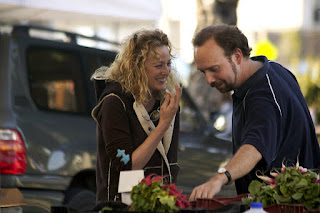 |
| Virginia Madsen and Paul Giametti, Sideways, 2004 |
Bill Turrentine, my boss, had inherited the fledgling company
from his father. When I started there were only eight of us. By now, there are
three times that many. I did database work, entering vineyard and sales data
and working with statistics and copy editing our newsletter. But I also
answered the phone. The people that created sales were important to us and I quickly learned their names!
In the early part of the decade, we spent a lot of time
finding grapes for Dennis Hill, a perfectionist winemaker and the magic behind Blackstone Merlot.
Derek and Courtney Benham had spent the previous ten years developing the
brand. Derek was a genius at it! Blackstone was so popular it was thought that
Millennials might start drinking wine rather than beer. In 2001 the Benhams
sold the brand and Derek Benham began another venture, determined to bring the elusive Pinot Noir
grape “to the people.” He had another great success with this project. Dennis
went on to found his own venture, Cannonball Wines.
Bill Turrentine and Ron McManis of McManis Family Vineyards
helped each other in many ways. The vineyards are near Ripon, a bit south of
Lodi, with a California appellation. Bill found the great winemaker Jeff
Runquist for the rapidly growing company. Jeff now has his own operation in the
foothills near Plymouth where he carefully selects the vineyards to go into his
mostly red varieties, Jeff Runquist Wines.
When you heard someone answer the phone and then break up in
giggles, we all knew that Paul Moser of Greenfield Wine Company, was on the
other end. Paul’s wines were deliberately European in style, more refined, and
not as “big” as some. His wines got high ratings from Robert Parker, but the company
was always under-capitalized and no longer exists. You might still find a Moser-Scharding wine, but don’t count on it. Gale Sysock of Delicato Vineyards was also
good for a smile and some good grape deals. He is now Vice President at the
large Delicato operation.
We didn’t have much to do with the Gallo organization,
but in the early years of the decade, harvests were often huge. Grape growers
called us begging us to find someone to purchase their grapes before they had
to let them dry on the vines. Fred Franzia, of Bronco Wine Company would come in at
the last possible minute and sweep up whatever vineyards were still available
at the lowest possible prices. Fred, a nephew of Ernest Gallo, was behind Two
Buck Chuck, or Charles Shaw Wines, which came to prominence during the decade,
sold mostly at Trader Joe’s.
Later I worked with Chris Smith
and Eric Aafedt
who make the wonderful Bogle wines. Though I learned to appreciate many wines,
most are beyond our price range. Bogle wines are not! We drink them often. Don,
my husband, has a favorite brand too: Bonterra. Bonterra wines come out of the
Fetzer family’s commitment to organic and sustainable vineyards. The great Paul Dolan began this tradition, before moving on to Mendocino Wine Company.
During the years I was at Turrentine, three movies came out
which also boosted the idea of wine drinking “for the people.” In 2004, Sideways
depicted an adventurous wine-drinking crawl through the Central Coast. Several
of its characters talked eloquently about wine, and memorably put down Merlot
in favor of Pinot Noir! (Hmmmm, could Derek Benham have had a hand in that?)
The movie was said to have quite an impact on wine consumption.
In 2005 came Mondovino, a documentary which quizzed
critics and tastemakers, trying to find out whether wine was losing its
typicity to global market demands. And in 2008 came Bottle Shock, a
dramatization of the so-called “judgment of Paris” in 1976 when, through a
series of misadventures, Chateau Montelena’s Napa Valley wines were judged
better than French wines in blind tastings.
The world wide web is full of stories about wine production.
Stories move us. They drive the culture. These stories are just the tip of
iceberg of those I heard at Turrentine Brokerage, where I was lucky enough to
work with great people, taste many California wines and get paid for it.

No comments:
Post a Comment